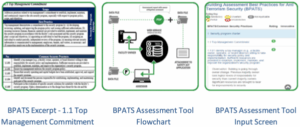ANTI-TERRORISM BEST PRACTICE LIST, ASSESSMENT PROCESS AND WEB-BASED TOOL FOR COMMERCIAL FACILITIES: Assessment approach that may be included in support of a SAFETY Act application should a building owner chose to seek protections.
The Department of Homeland Security (DHS) has national leadership responsibilities for managing risks involving critical infrastructure, key resources, and events. DHS has identified commercial facilities as key assets in the critical infrastructure/ key resource sector and encourages the widespread deployment of effective anti-terrorism technologies, services and capabilities. Building security programs are a technology that may receive designation under the Support Anti-terrorism by Fostering Effective Technologies Act (SAFETY Act) of 2002 as part of the Homeland Security Act of 2002, codified at 6 U.S.C. §441-444. Information about the SAFETY Act is available online.
To help commercial building owners and managers, the Science and Technology Directorate and the Office of SAFETY Act Implementation (OSAI) working in partnership with the government and private sectors identified a set of best operational security practices for metropolitan commercial office buildings, referred to as Best Practices for Anti-Terrorism Security (BPATS). There was also a need for an assessment methodology that could be used to record and compare a facility’s practices to the BPATS. OSAI worked with the National Institute of Building Sciences (NIBS) to develop a corresponding web-based methodology for performing security assessments on commercial buildings. The online tool and its Field Guide provide a recommended process that can be used to improve the content and persuasiveness of assessments.

ach of the common security practices has several specific, tactical-level security actions, procedures, methods, equipment or systems related to preparing for, preventing, mitigating and recovering from acts of terrorism. A building owner/operator may wish to consider these practices when developing its anti-terrorism security program. While this is a comprehensive set of BPATS, it also is scalable; a facility would not be required to satisfy all of the BPATS. Rather, building owners/operators should consider the appropriate level of security measures necessary to mitigate the risk to that facility.
OSAI conducted a pilot with the National Institute of Building Sciences to determine whether the BPATS produce the outcome OSAI seeks, which is to help a building owner make informed risk-based decisions to better prepare for emergencies. The pilot looked at six buildings: two in Washington, D.C.; one each in Los Angeles, Chicago, New York and Denver.
With each building review, OSAI and NIBS have been able to refine both the BPATS and the assessment tool to ensure that an assessor would be able to provide feedback that later would be used to help a building owner make informed risk-based decisions. This will also help a building owner highlight the outcome of the risk assessment and the steps the building owner took to address the risk assessment, as the building owner prepares an application for SAFETY Act protections, should the building owner wish to apply.
Availability and Use
Best Practices for Anti-Terrorism Security (BPATS): The BPATS list may be downloaded as a PDF from the resource section of the online BPATS Tool.
Assessment Process Guide and Example Report: The Field Guide for Conducting BPATS Based Assessments of Commercial Facilities along with an example report may be downloaded from the resource section of the online BPATS Tool.
Web-Based Tool: Building Owners and Assessors may apply for access to the web-based BPATS Tool. Access to the Tool is free and training is also available free of charge in both live and on-line versions. To ensure that applications of the BPATS are consistent and thorough, Assessors must identify their security credentials to obtain training and to use the web-based tool.
Contact Information
Roger J. Grant, CSI, CDT
Executive Director, Building Information Management
National Institute of Building Sciences
bpatstool@nibs.org



